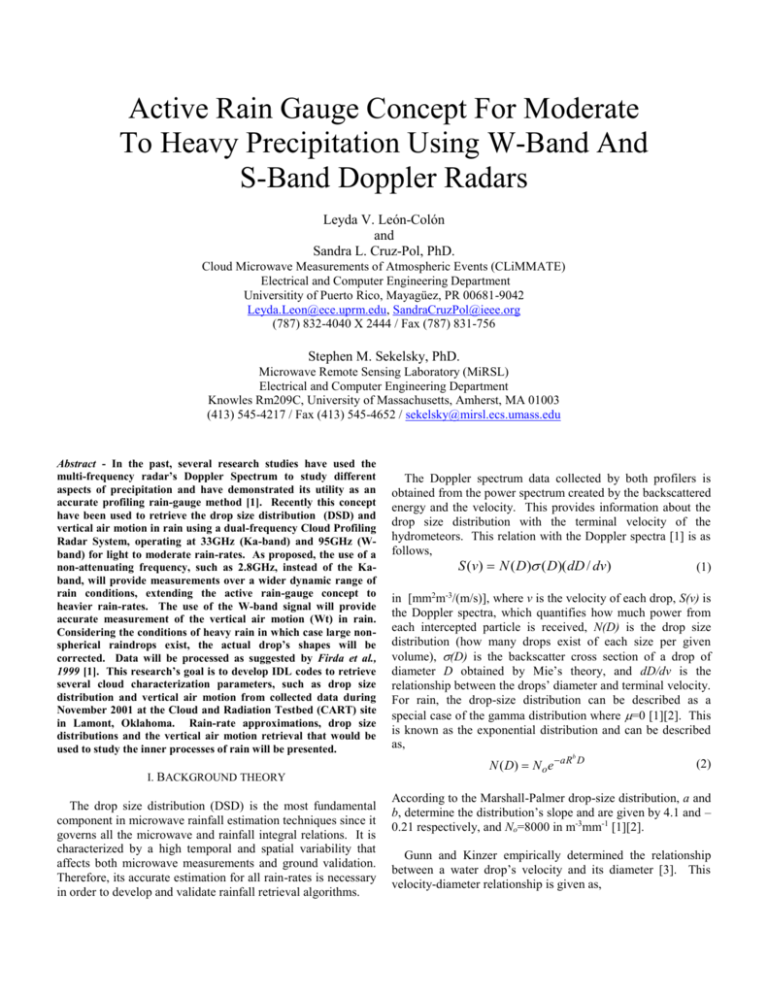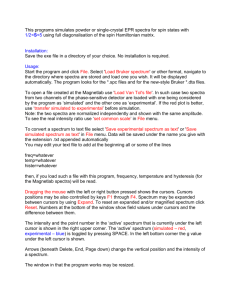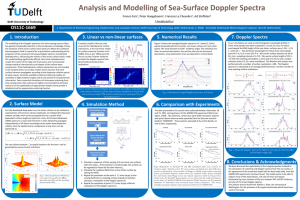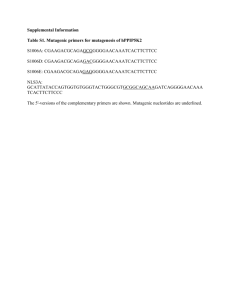Active Rain Gauge Concept For Moderate To Heavy Precipitation
advertisement

Active Rain Gauge Concept For Moderate To Heavy Precipitation Using W-Band And S-Band Doppler Radars Leyda V. León-Colón and Sandra L. Cruz-Pol, PhD. Cloud Microwave Measurements of Atmospheric Events (CLiMMATE) Electrical and Computer Engineering Department Universitity of Puerto Rico, Mayagüez, PR 00681-9042 Leyda.Leon@ece.uprm.edu, SandraCruzPol@ieee.org (787) 832-4040 X 2444 / Fax (787) 831-756 Stephen M. Sekelsky, PhD. Microwave Remote Sensing Laboratory (MiRSL) Electrical and Computer Engineering Department Knowles Rm209C, University of Massachusetts, Amherst, MA 01003 (413) 545-4217 / Fax (413) 545-4652 / sekelsky@mirsl.ecs.umass.edu Abstract - In the past, several research studies have used the multi-frequency radar’s Doppler Spectrum to study different aspects of precipitation and have demonstrated its utility as an accurate profiling rain-gauge method [1]. Recently this concept have been used to retrieve the drop size distribution (DSD) and vertical air motion in rain using a dual-frequency Cloud Profiling Radar System, operating at 33GHz (Ka-band) and 95GHz (Wband) for light to moderate rain-rates. As proposed, the use of a non-attenuating frequency, such as 2.8GHz, instead of the Kaband, will provide measurements over a wider dynamic range of rain conditions, extending the active rain-gauge concept to heavier rain-rates. The use of the W-band signal will provide accurate measurement of the vertical air motion (Wt) in rain. Considering the conditions of heavy rain in which case large nonspherical raindrops exist, the actual drop’s shapes will be corrected. Data will be processed as suggested by Firda et al., 1999 [1]. This research’s goal is to develop IDL codes to retrieve several cloud characterization parameters, such as drop size distribution and vertical air motion from collected data during November 2001 at the Cloud and Radiation Testbed (CART) site in Lamont, Oklahoma. Rain-rate approximations, drop size distributions and the vertical air motion retrieval that would be used to study the inner processes of rain will be presented. I. BACKGROUND THEORY The drop size distribution (DSD) is the most fundamental component in microwave rainfall estimation techniques since it governs all the microwave and rainfall integral relations. It is characterized by a high temporal and spatial variability that affects both microwave measurements and ground validation. Therefore, its accurate estimation for all rain-rates is necessary in order to develop and validate rainfall retrieval algorithms. The Doppler spectrum data collected by both profilers is obtained from the power spectrum created by the backscattered energy and the velocity. This provides information about the drop size distribution with the terminal velocity of the hydrometeors. This relation with the Doppler spectra [1] is as follows, S (v) N ( D) ( D)( dD / dv) (1) in [mm2m-3/(m/s)], where v is the velocity of each drop, S(v) is the Doppler spectra, which quantifies how much power from each intercepted particle is received, N(D) is the drop size distribution (how many drops exist of each size per given volume), (D) is the backscatter cross section of a drop of diameter D obtained by Mie’s theory, and dD/dv is the relationship between the drops’ diameter and terminal velocity. For rain, the drop-size distribution can be described as a special case of the gamma distribution where =0 [1][2]. This is known as the exponential distribution and can be described as, N ( D) N o e aR b D (2) According to the Marshall-Palmer drop-size distribution, a and b, determine the distribution’s slope and are given by 4.1 and – 0.21 respectively, and No=8000 in m-3mm-1 [1][2]. Gunn and Kinzer empirically determined the relationship between a water drop’s velocity and its diameter [3]. This velocity-diameter relationship is given as, v(D) 9.25 1-e (-6.8 D 2 4.88D ) (3) in [m/s]. To account for the air density (which decreases with the increasing altitude), this equation is multiplied by a correction factor of (o/)0.4, for which radiosonde data will be used. Vertical air motion (updrafts and downdrafts) and turbulence, all bias the measured signal. These effects must be removed from the radar data to obtain the true DSD. The dualfrequency method uses the Mie scattering null-effect observed at microwave frequencies to remove biases due to the Wt. Lhermitte work showed that the Doppler spectrum depends on frequency; however the drop-size distribution does not. Plotting both frequency spectra (at 95GHz and 33GHz), it follows that the Ka-band has a Gaussian shape and the W-band has several peaks and nulls that will be used to calculate the vertical air motion [1][5]. N(D) until the quantity at both frequencies are (there is only one drop-size distribution and it is frequency independent) [1]. The new spectrum is then calculated using this unique distribution, and this is repeated several times to make the spectrum independent from the first simulation. This is the spectrum calculated for just one cell. The next cell’s spectrum is then calculated using the latest DSD calculated as an initial guess. This process continues until the first profile is completed; then the next profile is calculated. These next profiles work with the N(D) adjacent to each cell of the past profile [4]. III. RESULTS AND CONCLUSIONS Data was collected for a period of 3 hours. Fig. 1 shows the data collected for hour 21:00 UTC for both radars. The W-band collected data showed frequency aliasing (Fig. 2), i.e., detected velocities that are higher than the maximum values the radar can detect. The radar reflectivities for both radars are determined from, Ze 4 2 Kw 5 S (v)dv (5) 0 where Kw is calculated from the refraction index of water and is the wavelength of the radar in free space [1]. The dualwavelength ratio, DWR, is calculated using both radar reflectivities by, DWR=10log10(Ze2.8/Ze95). The one-way attenuation can be calculated as, The first cell was considered at a height of 714 meters. The collected radiosonde data was used to calculate the Mie scattering and backscattering coefficients obtained for the Sband and W-band as a function of the particle’s diameter (Fig. 3). The cell medium condition is considered in order to get accurate simulated values. K 4.34 *10 3 N ( D) e ( D)dD (6) 0 in [dB/km], where e is the extinction cross section [4]. II. METHODOLOGY The proposed data analysis (based upon Firda’s work) [1] starts from a single range cell with simulated values and iterating until being independent from them, moving up to the next higher cell until the whole profile is done and then it moves up to the next time profile as explained in [6]. It starts up simulating reflectivity, the attenuation, the spectrum and the scattering cross section at both frequencies. This is done using the Mie theory and radiosonde data (which takes into account the temperature at that cell, hence the medium properties). Next, simulated DWR is calculated and compared to the measured one. This step is repeated adding different rain-rates (see equation 2) until both quantities are the same, indicating the real rain-rate. Using this rain rate, the spectra can be plotted simulated. To extract the vertical air motion, the velocity axis is moved until the first nulls of the measured and simulated spectra correlates. Turbulence is then estimated by convolving (D) with simulated turbulence and calculating Figure 1: Data collected for hour 21:00 UTC on November 8, 2001. Figure 2: Data aliasing observed in collected W-band Data Figure 6: Turbulence spectra for a width of 0.5m/s VS. Velocity. Once the Mie coefficients are obtained, Ze2.8 and Ze95 were simulated. Two-way attenuation was calculated and removed from the retrieved reflectivities. Then the simulated DWR was calculated (Fig. 4) and compared to measured DWR. Figure 3: Mie backscattering coefficients as a function of the particle diameter (a) 2.8GHz (b) 95GHz. Figure 4: Simulated DWR VS. Rain-Rate with and without attenuation. After several iterations, we found that the simulated and measured values were equivalent when the rain-rate was 4.92025 mm/hr assuming the Marshall-Palmer drop size distribution N(D). Using this rain-rate, the spectrum was simulated. Once attenuation was removed from the simulated data, both spectra (simulated and measured) were plotted (Fig. 5) to see the shifting in the velocity axis caused by the vertical air motion. The measured spectra showed to be biased for a Wt=1.5m/s and was corrected by it. Once we determine Wt, we consider turbulence which follows a Gaussian distribution [2][6]. A turbulence spectrum for a width of 0.5m/s is shown in Fig. 6. For the first profile’s first cell was found that the rain-rate was about 4.92 mm/hr. With this values, a Marshall-Palmer N(D) was approximated to simulate the Doppler spectra and this way compare it to the measured one to see the Wt effect. The vertical air motion for this first iteration was found to be around 1.5 m/s, so the measured spectrum was shifted by this value. Now turbulence can be removed and several iterations can be done to obtain results independent from the simulated starting values obtaining the real cell’s DSD. Future work includes extending these codes to all the cells within the rain cloud. REFERENCES [1] Firda, John M., “Application of Dual-Frequency Millimeter-Wave Doppler Spectra for the Retrieval of Drop Size Distributions and Vertical Air Motion in Rain”, Journal of Atmospheric and Oceanic Technology, 16, pp.216-236, 1999. [2] Doviak, Richard J., Zrnić, Duśan S., Doppler Radars and Weather Observations, Academic Press, Second Edition, 1993. [3] Gunn, R., G.D. Kinzer, “The terminal velocity of fall for water droplets in stagnant air.”, J.Meteor., 6, pp.243-248, 1949. [4] Lhermitte, R., “Observations of rain at vertical incidence with a 94GHz Doppler Radar: An insight on Mie Scattering”, Geophysical Research Letters, 15, pp.1125-1128, 1988. [5] http://www.ece.uprm.edu/climmate/publications/4882-44.pdf [6] Sauvageot, Henri, Radar Meteorology, Artech House, Inc.,1992. Figure 5: (a) Simulated (using rain-rate = 5.05316) and Measured spectra.








